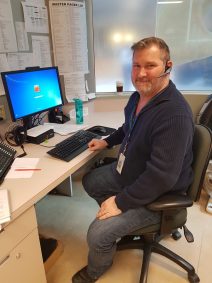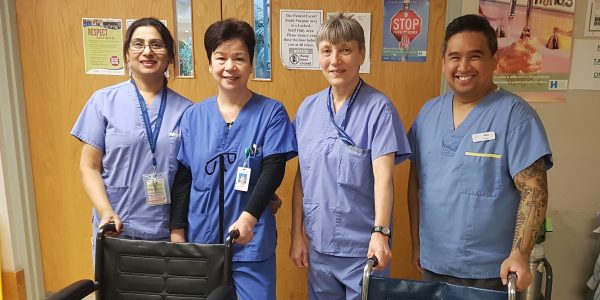Life underground: spotlight on Patient Transport
In our ongoing series on the people who work in the VGH tunnel, we profile Patient Transport. This team traverses our underground tunnel, transporting patients between buildings on the VGH campus and as far as the BC Cancer Agency for treatment.
Patient Transport
Location: Main dispatch is on the ground floor of Jim Pattison Pavilion, beside the Diamond Family Courtyard. Porters can be found just about anywhere on campus, including in the tunnel.
Staff: 140 porters (many of whom work at both VGH + UBCH)
Hours of operation: 24/7
Weekly patient trips: Approximately 6,200 (more than 430 in the tunnel)
“The ability to humanize this place is really important. That’s what our porters do. They provide a human face for the hospital.” – Mary Heim, supervisor, patient transport.What is Patient Transport?
“We’re ambassadors for the hospital,” says Mary Heim, supervisor, patient transport. “We’re everywhere, on every floor, in every department – we keep this place moving. Without us, the movement of patients in the hospital would stop. Patients wouldn’t be able to go for tests and admitted patients wouldn’t be moved up to the ward.”
What does Patient Transport do?
The team transports admitted patients of all acuity levels from units and the Emergency Department to Medical Imaging or other appointments around the hospital. They’re responsible for moving patients throughout their health care journey on campus and, sadly, this sometimes includes transport of the deceased to the morgue in the VGH tunnel.
“Every trip is different. Every person is different,” says Mary. When they’re not transporting patients, porters transport vital tools of the trade, including lab specimens, blood products and patient charts.

Sean Stevens dispatch coordinator, patient transport
Dispatchers, known as “air traffic control,” oversee transport requests at VGH and UBCH. “We can easily get over 200 calls per shift,” says dispatch coordinator Sean Stevens. “It’s busy, and no two days are the same.”
How does Patient Transport support the delivery of quality patient care?
“We’re the bridge between the clinical side and the patient,” Mary says. “We often spend a significant amount of time with patients during transport, so we can talk to them. You’ll see patients laughing and being able to let go of where they are for that five or 10 minutes while they’re with the porter. They’ll be talking about the soccer game or where they went for their vacation before they were here.”
“I love being a porter,” says JP. “It’s great meeting all of the different people that come through here, seeing them get well and then saying goodbye to them as they’re walking through the halls. They often stop you in the halls looking much better and say, ‘Hey, remember me? You transported me.’”
How does Patient Transport support innovation in health care?
When we think of innovation, we often think of technology. While Patient Transport may not be on the forefront of technology – using pagers and telephones – for them, innovation comes from finding new ways to connect with each and every patient.
“I had a patient who was in hospital for quite a few months,” says porter Michael Esmeria. “She was blind and when I’d come into the room, she’d recognize me and say, ‘Oh Michael, you’re here?!’ She’d ask all of the other porters if I was around to help her. She was a really nice lady and I enjoyed talking with her. We see a lot of patients over and over and it’s really great to get to know them.”
Did you know?
- VGH porters walk an average of 14 km each day.
- During a 24-hour period, approximately 44 porters are on-shift at VGH on any given weekday; 23 on a weekend.
- Porters do an average of 25 to 30 trips per shift.
- Some of our senior porters have walked the equivalent of nearly three times around the world.
- An average weekday for a VGH porter consists of:
- 1,050 trips
- 143 Blood Bank Trips
- 54 Lab deliveries
- 73 patients to the OR
- 54 Emergency transfers
- 240 Medical Imaging appointments
- 53 Pharmacy runs


Lois Budd
Porters are another group of unsung heroes in healthcare. As Mary says, they keep the place moving, delivering patients and needed items from one place to another, saving unit staff footsteps and time spent away from frontline care. Like all the support services, they allow bedside staff to do their jobs safely and efficiently. Most importantly, they are a comforting presence to the patients they transport. Thank you porters!
Heather Noullett
I’m a VCH employee who got the chance to experience healthcare from a patient’s point of view last summer when I spent a few days in VGH, both in Emergency and on an inpatient medical unit. Chatting with the porters while I was being transferred from place to place was one of the most enjoyable parts of my stay! Each one took the time to talk to me, make me laugh, and make me feel at ease at a time when I was experiencing fear and anxiety about my health. Thank you so much, porters! You have such an important role in providing comfort to patients and you do it really well.